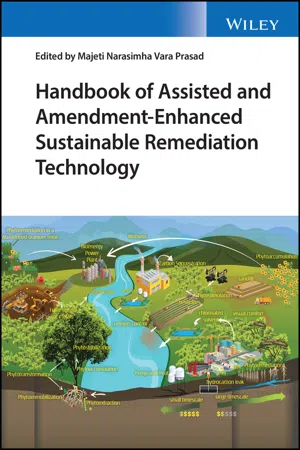
Handbook of Assisted and Amendment-Enhanced Sustainable Remediation Technology
- English
- ePUB (mobile friendly)
- Available on iOS & Android
Handbook of Assisted and Amendment-Enhanced Sustainable Remediation Technology
About This Book
Learn more about phytoremediation technology with this state-of-the-art resource from an internationally recognized editor and leader in his field
The Handbook of Assisted and Amendment-Enhanced Sustainable Remediation Technology discusses sustainable approaches to the removal of contaminants from the environment or the reduction of their toxicity. The distinguished editor has included resources from an internationally recognized group of academics who discuss strategies to increase the effectiveness of phytoremediation.
Special attention is paid to the use of organic amendments to facilitate soil cleanup and the growth of phytoremediation plants. The book includes discussions of new remediation technologies, global trends in the environmental remediation industry, and the future challenges and opportunities likely to arise in the short and long term.
The Handbook of Assisted and Amendment-Enhanced Sustainable Remediation Technology provides a compelling case for the cost-effectiveness, aesthetics, and minimal environmental disturbance of phytoremediation. Topics covered include:
- A discussion of activated carbon from lignin, particularly its use as a sorbent for in situ remediation of contaminated sediments
- An exploration of fresh and mature organic amendments for phytoremediation of technosols contaminated with high concentrations of trace elements
- An examination of the revitalization of metal-contaminated, EDTA-washed soil by addition of unpolluted soil, compost, and biochar
- A treatment of wheat straw biochar amendments on the removal of polycyclic aromatichydrocarbons (PAHs) in contaminated soil
Perfect for environmental engineers, environmental scientists, geologists, chemical engineers, and landscape engineers, Handbook of Assisted and Amendment-Enhanced Sustainable Remediation Technology is also an indispensable reference for scientists working in the green chemistry and technology industries, biochemical engineers, environmental regulators, and policy makers.
Frequently asked questions
Information
Part I
Global Scenario of Remediation and Combined Clean Biofuel Production
1
Global Remediation Industry and Trends
1.1 Introduction
1.1.1 Rise of Phytoremediation

Table of contents
- Cover
- Table of Contents
- Title Page
- Copyright
- List of Contributors
- Preface
- Part I: Global Scenario of Remediation and Combined Clean Biofuel Production
- Part II: Biochar‐Based Soil and Water Remediation
- Part III: Organic Amendments Use in Remediation
- Part IV: Advanced Technologies for Remediation of Inorganics and Organics
- Part V: Microbe and Plant Assisted Remediation of Inorganics and Organics
- Part VI: Nanoscience in Remediation
- Index
- End User License Agreement